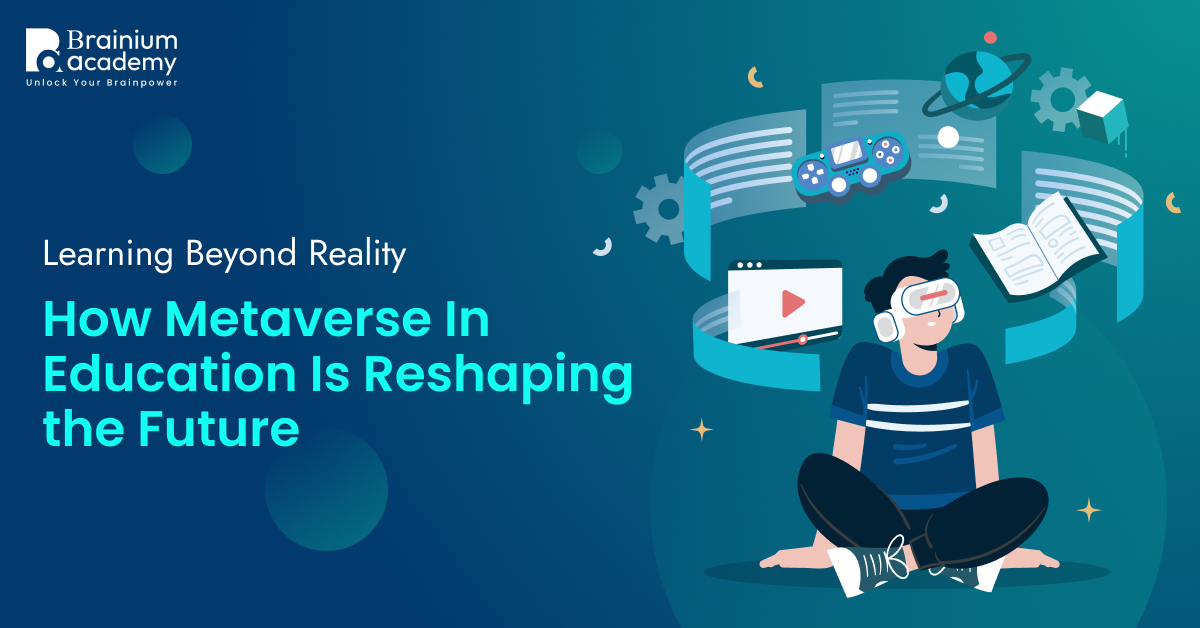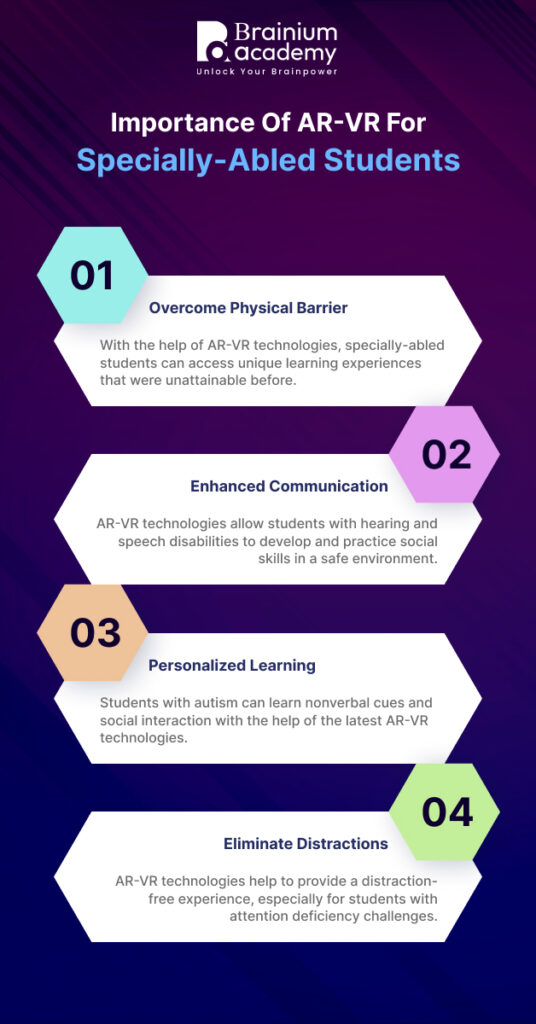
Learning Beyond Reality: How Metaverse In Education Is Reshaping the Future
Over the last few years, the education sector has undergone radical changes due to the metaverse. Say, for example, digital whiteboards have replaced traditional blackboards. In most educational institutions, computers and various types of other technologies and software are now being used to aid education. This digital transformation due to the metaverse in education tends to integrate various immersive technologies into academic curricula that help in making learning fun and engaging.
But before diving in, let us first try and understand what exactly Metaverse is in the education sector.
Understanding Metaverse
Metaverse is a three-dimensional cyberspace that integrates various aspects such as online gaming, social media, augmented reality (AR), and virtual reality (VR) allowing users to interact virtually. The metaverse’s main advantages are that it is persistent, present in real-time, and always active. Furthermore, it tends to overcome the limitations of physical barriers in order to provide valuable services to the users. Due to the metaverse in the education sector, there have been collaborative virtual campuses and classrooms where students can interact with 3D simulations and virtual experiments.
What is metaverse in the education sector?
With the advancement of technology, the metaverse tends to provide a unique opportunity in order to improve learning outcomes by providing an immersive, personalized, and exceptional learning experience. Unlike traditional learning method that believes in one size fits all, the metaverse follows a student-centric approach where each and every learner’s learning style and needs are taken into consideration. Difficult concepts are broken down and understood with the application of the metaverse in education, thereby making learning more interesting and engaging.
In addition, the use of metaverse in education also tends to facilitate experimental learning where students can perform virtual experiments, and do collaborations that are impractical or impossible inside a physical classroom. For example, students can explore the solar system or dive deep into The Mariana Trench, while sitting inside the four walls of a classroom. This, in turn, helps to foster critical thinking, creativity, and problem-solving skills among the students, thereby preparing them for the future.
According to a recent report, the market size for the metaverse in the education sector is expected to show an annual growth rate (CAGR 2023-2030) of 43.67%, resulting in a projected market volume of US$ 24.0 bn by the year 2030. Hence, it holds a prospective future for students willing to learn the ‘know-how’ of the metaverse.
Marketing in the metaverse is different from traditional digital marketing away from flat media, such as images, texts, and video. Advertising in a digital environment may include virtual spokespeople (VSPs) using avatars, virtual Product Placements (VPPs) where products are shown to a targeted audience only at a specific time or place in the virtual world, and virtual billboards.
In addition, with the advancement of technology, ChatGPT, the AI chatbot can act as a virtual assistant within the metaverse education platform, helping students navigate the virtual world, providing useful information, and answering various questions. ChatGPT helps to enhance immersion and make interaction more human-like. This in turn helps to improve overall user experience. Hence students can opt for the latest short-term ChatGPT courses and gain practical skills and knowledge knowledge to effectively integrate ChatGPT in the metaverse.
Also read: From Novice to Expert: How a ChatGPT Course Elevates Your Career
What are the advantages of metaverse in education?
There are numerous benefits of metaverse education such as:
- Immersive learning
In today’s technological age, educational institutions tend to offer an interactive and holistic curriculum that includes real-time experience with the help of the metaverse. This helps the student to view and interact with his or her peers and local surroundings just like physical surroundings. Metaverse in education helps to transport students virtually to various places in order to create a more inclusive and accessible learning experience. Imagine discovering 15th-century America with Columbus or traveling to the moon with Neil Armstrong, it would be great, isn’t it?
- Hands-on practice
The latest metaverse technology in education helps students engage in hands-on practices in a safe environment, which can otherwise be difficult and risky to do in a real-world setting. Students can have a better understanding of the theories and be prepared for all the challenges in real life. Students can conduct explosive experiments or do complex surgeries without risking anyone’s life in a metaverse.
- Increased learning speed
Metaverse in the education sector provides students with a more engaging and immersive learning experience. This, in turn, can help to increase students’ motivation and overall interest in learning faster as he or she can interact and explore more due to engrossing hands-on practices, gamification, and 3D elements.
- Gamification
Gamification refers to the process of integrating something with game elements in order to encourage user participation. Gamification in the metaverse for students tends to combine the elements of learning and entertainment to increase participation and engagement from students. This helps students to keep learning and complete assignments on time.
What are the various applications of metaverse in education?
The metaverse in education has the following applications:
- Virtual 3D classrooms
There has been a rise in online schools and colleges with the advent of the metaverse in education. Students can virtually meet and interact with their teachers and classmates with the help of virtual 3D classrooms. Metaverse-powered learning setup removes all the physical barriers and allows students and teachers to take part from any part of the world.
- Digital learning
The use of Metaverse in education helps to enhance a student’s overall learning experience with the help of smart classrooms. The use of video in education helps in a better understanding of the subjects. The audio and visual nature of a video tends to appeal to a larger group of students, helping them to process and recall information in a better way. The best part is that even physical classrooms can now use 3D virtual learning methods in order to achieve a better learning outcome.
- Virtual campus activities
The metaverse technology in education encourages students to take part in different co-curricular activities such as arts and sports in a safe virtual environment. Students can participate in various fun interactive activities such as literature club, quiz club, and music club right from the comfort of their homes.
- Creating stimulation for real-life situations
The metaverse in the education sector helps to engage students and increase their overall understanding by replicating real situations in a safer environment. He or she can now conduct scientific experiments, showcase prototypes, and much more with the help of the latest augmented reality (AR) and virtual reality (VR) tools all while sitting at home.
- Creating awareness
The latest metaverse technology in education can be used in the classroom in order to build awareness related to various social causes such as pollution, famine, or climate change among students. For instance, students can be shown videos and documentaries on poverty in Burundi or famine in Somalia, so that they can have a better knowledge of their difficult situation. With the help of such interactive and immersive learning, students can not only gain theoretical knowledge but will also get a deeper emotional understanding of various things happening all around the world.
- Virtual educational tours
Would it be an amazing experience, if you could travel to a new historic palace while reading about it in a classroom? Although it is not possible in real life, the metaverse technology in education makes it feasible by providing virtual worldwide tours. With the help of this feature, a student can travel to any place of his or her choice within a few seconds in a virtual setting. This in turn also helps to expand their horizons and broaden their worldviews.
- Events and special guests
Education institutions can invite eminent personalities and skilled professionals from industries into the virtual world of the metaverse in order to help students learn from their various life experiences. Students can attend engaging online conferences, symposiums, and lectures with the help of the latest metaverse technology in education.
About AR and VR in the metaverse
Augmented reality (AR) uses technology to augment or enhance a person’s view of reality with the help of digital visual elements, sound, and other sensory stimuli. Remember the Pokémon Go game on the phone that has taken the world by storm? The player has to catch characters based on their real locations on a map. The main idea behind the game is to overlay digital imagery on a person’s view of the real world, using a smartphone screen or a headset.
Augmented Reality technologies allow teachers and educators to incorporate personalized, game-based learning that extends beyond the traditional classroom. The use of AR in the education sector improves the learning environment by driving student engagement and better understanding of the subject.
On the other hand, virtual reality (VR) tends to create a virtual simulated environment with the help of VR goggles, VR headsets, or other electronic devices. The user can enter and interact with computer-generated stimulation in such a way that it may seem real.
Importance Of AR-VR For Specially-Abled Students

The use of metaverse technology in the education sector allows teachers and educators to incorporate personalized, game-based learning that extends beyond the traditional classroom. The use of AR-VR technologies in the education sector improves the learning environment by driving student engagement and a better understanding of the subject in a safe protected environment.
Now let us look into some of the reasons why AR-VR technology is significant for especially abled students-
- Remove physical barriers
People can travel to faraway exotic places, even to alien worlds, with the help of various augmented reality (AR) and virtual reality (VR) tools. Due to the metaverse in the education sector, students with disabilities can access unique learning experiences and navigate a virtual world at will, which they could not do before with the help of the latest AR-VR technologies. He or she can visit historic places, and learn about art and technologies sitting in a wheelchair.
- Better communication
Communication is one of the biggest challenges that are faced by specially-abled people. Due to the metaverse for students, lots of augmented reality (AR) and virtual reality (VR) tools have been developed that help students with speech and hearing disabilities develop and practice social skills in a secure environment.
- Customised learning
The use of metaverse technology in education such as the latest augmented reality (AR) and virtual reality (VR) tools has helped to provide unique learning experiences, particularly for differently-abled students who have special needs and different learning styles. For example, students with autism can learn nonverbal cues and social interaction with the help of the latest AR-VR technologies.
- Reduce distractions
The immersive environment of the metaverse for students has helped to encourage sustained attention and focus. Students with attention deficiency challenges are able to receive a distraction-free experience with the help of the latest AR-VR technologies which make them feel more comfortable and less anxious.
Challenges in the metaverse for education
Just like every coin has two sides, the metaverse in the education sector also comes with various challenges
- Cybercrime
Cybercrime has been considered a serious problem ever since the internet came into existence. Governments all around the world have spent billions of dollars almost every year to improve the security levels of current internet systems.
However, since the metaverse for students is a relevant new subject, it still requires sophisticated cybersecurity laws. Furthermore, due to the decentralized aspect of the metaverse, the government does not have much power to fight and counter cybercrime. Hence there have been cases of cyberbullying more so among young school and college-going students.
- Losing touch with the real world
The metaverse in the education sector tends to blur the boundary between the online world and the physical world. At times it becomes so influential, that people especially young teenage students tend to give more importance to the digital world than the real world.
- Hardware and connection issues
The metaverse in the education sector requires reliable and faster hardware devices and a 5G internet connection. Students who come from humble backgrounds would not be able to afford such high-end technologies.
- Addiction issues
There can be serious health issues, especially with young teenagers who are fully immersed in a virtual world. Spending too much time online tends to cause some harm to their overall health and brain development. There should be a balance between the real world and the metaverse in education.
Wrapping up
It is to be kept in mind that the metaverse in the education field cannot be considered as the replacement for traditional classrooms but as a useful additional tool that tends to make learning more engaging, effective, and engaging.
Although still in a very early stage, the metaverse has the potential to transform the education landscape. It helps to create a landscape that is immersive, personalized, and experimentally rich. Many education institutions are now providing metaverse learning courses for a better understanding of the subject. Search for the best course near you today!
